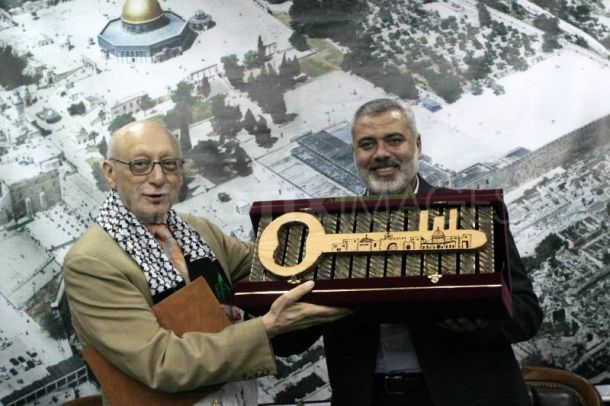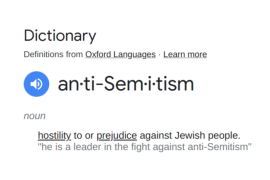A guest post by AKUS
The next time you see an article by Harriet Sherwood about Israel or the Palestinians, don’t waste time reading it.
Just use a search engine to go to the source or alternative media. After all, that seems to be how she gets her regurgitated “news”. You’ll get the news straight, and you’ll very likely get information she omits so that she can comply with the Guardian World View of Israel as Absolutely, Positively, the Most Awful Place in the Known Universe including that planet 127 light-years away.
Take one of several examples I could choose: Sherwood’s recent story about the lack of classrooms for Arabs in East Jerusalem – Palestinian children in East Jerusalem face classroom shortage, says report. Sherwood breaks the news to an unbelieving world that, unlike students in school systems anywhere else,
“Almost half the Palestinian children in East Jerusalem are forced to attend private or unofficial schools because of a lack of classroom facilities provided by the Israeli authorities, according to a new report.”
In passing, note the use of the inflammatory “children … forced to” rather than “children … have to”, which is how this situation would be reported for the rest of Israel or, for that matter, the USA or UK.
You would have done better to go straight to the report or CNN than read Sherwood’s rehash. Sherwood’s article replicates sections of a similar article published a few hours earlier than hers by CNN without actually mentioning CNN and omits selected important sections of the report she cites.
CNN: Report: Classroom shortage hurts East Jerusalem children
I originally noted that the CNN article was published 10 hours earlier than Sherwood’s. It was later updated to 1721 GMT. It includes the following direct attribution of a statement by a spokeswoman for ACRI to CNN, Ronit Sela:
“We call it discrimination … discrimination in budget allocation and a severe neglect of the entire system,” Ronit Sela, a spokeswoman for the Association for Civil Rights in Israel (ACRI), told CNN. ACRI is one of the two organizations, along with the group Ir Amim, which published the report. “This school year is going to start with a shortage of about 1,000 classrooms for Palestinian children in East Jerusalem, and only 39 classrooms have been built this year despite promises made in past years to build 645 by 2011,” said Sela.
(I have provided a more balanced view from Sela’s own report in some analysis below).
Sherwood: Palestinian children in East Jerusalem face classroom shortage, says report
Note the careful wording, because unlike CNN, which went to the source, Sherwood refers to the report but has no attribution to a direct statement by Ronit Sela or other spokesperson. I’ve underlined the sentences she used directly from the report. If this is reporting, you too can be a Guardian reporter:
It estimates that East Jerusalem schools are short of around 1,000 classrooms, and says that only 39 were built in the last academic year. “The continuing neglect of the Arab education system in Jerusalem has caused a severe shortage of classrooms. The result is that in the 2010-11 school year the families of thousands of Palestinian children will have to pay large sums of money to get the education they should have been getting for free,” it said.
This is taken in large part from the Introduction to the ACRI-Ir Amim report:
“The continuing neglect of the Arab education system in Jerusalem has caused a severe shortage of classrooms and this year again the Ministry of Education and the Municipality of Jerusalem have avoided addressing that shortage in any meaningful way. The result is that in the 2010-2011 school year the families of thousands of Palestinian children will have to pay large sums of money to get the education they should have been getting for free.”
The CNN news item goes on to cite a response from Jerusalem’s City Hall, which Sherwood does not, thus completely distorting the situation:
“Investment and staff have been significantly enlarged and in the past two years several new schools have been built in East Jerusalem housing 200 new classrooms. City Hall is currently building additional classrooms and 248 projects are under construction.
“City Hall is investing in East Jerusalem beyond the norm by its investments and fundraising for the distribution of computers to close the gaps with the Ministry of Education.”
In addition to the schools it has built, the city said others are planned, including renovations plus added facilities in two neighborhoods north of Jerusalem.
“In 2007/2008 two schools were built in the Sur Bhar neighborhood — one primary, one comprehensive. In addition, there is planned construction of new building of two wings of schools in Shufat and new structures in Umm Tuba, which are in the advanced planning stage,” according to the city.
You could also read the same news in Ha’aretz, with the advantage, as with CNN, of receiving a fuller view of the issue. I’ll cite the municipality’s rebuttal that Ha’aretz provided – you can read Ha’aretz’s rehash of the ACRI-Ir Amim report in full on their web-site:
NGOs slam city hall for lack of East Jerusalem classrooms
“The Jerusalem municipality rejected the report’s criticisms. According to the municipality, there is a shortage of just 700 classrooms in East Jerusalem. In the last two years, the city has built 200 new classrooms while another 230 are in the process of being furnished, the municipality said.”
“The shortage of classrooms stems primarily from the lack of available property that can be designated for the construction of educational institutions,” the municipality said in a statement. “Given this set of circumstances, the municipality is providing various housing solutions by making available mobile homes … and building new schools.”
(It is of course ironic, as this comment hints, that the very same people demanding a cessation of Israeli building in East Jerusalem, which they regard as illegal, also complain that the Jerusalem municipality is not building enough (illegal?) classrooms for Arab students!!)
In fact, Sherwood omits a key section of the ACRI- Ir Amim report which she relied upon for the rest of her column. While obviously displeased with the rate of progress, the report points out that there is considerable activity intended to reduce the lack of classrooms – slightly over half the needed number (338 classrooms) will be built within the next 15 months:
Since 2001, 257 classrooms have been built in East Jerusalem. By the end of 2010 the construction of a comprehensive girls’ school in Ras al-Amud is scheduled to be completed with 39 classrooms. In 2011 another 42 classrooms are supposed to be built but completion of their construction by that time is not guaranteed.
Even if all of the planned classrooms are built, a total of only 338 classrooms will have been built by the end of 2011, which are at most 52% of the classrooms the authorities promised to build.
Moreover, it is not clear that the implication that thousands of Arab families pay for their children’s education is even true. The ACRI-Ir Amim report provides the following table:
I suspect that “unofficial schools Recognized but” is a right-to-left formatting error from the Hebrew, and should read “Recognized but unofficial schools”.
According to the report, “Private schools” include “UNRWA (United Nations Relief and Works Agency), organizations connected to the Palestinian Authority and commercial bodies whose main motive is profit-making”. I would be most surprised if the students were charged for attending any but the “profit-making” schools. The Waqf schools are what we would refer to in the USA as a “parochial school”, and the Waqf is a well-funded organization – it would be interesting to know if students at its schools are charged anything more than a nominal fee. There are similar religious and private schools in the Jewish sector. Thus, although the table indicates that only half the Arab children learn in municipal schools, it is not clear that all the other 50% pay fees. Even if there were enough municipal classrooms for all Arab students, I suspect that there would be a proportion that would choose alternative schools.
Since Sherwood seems to get her “news” from other sources, I checked what Ha’aretz has to report about classrooms in Israel – perhaps I can get a job as a Guardian Middle East reporter if my googling skills are up to scratch. Here’s a report from 2007 about Israel’s 5 – year plan for new classrooms:
Cabinet okays NIS 4.6b 5-year plan for 7,000 new classrooms
(That’s over a billion dollars – not small change for a small country)
“At its weekly meeting in Jerusalem yesterday, the cabinet approved the Education Ministry’s five-year, NIS 4.6 billion plan to construct 7,000 new classrooms.”
“According to the ministry’s plan, roughly 550 new classrooms will be built in the Arab sector each year, about 390 new classrooms will be built annually in the ultra-Orthodox sector, and an estimated 460 rooms will be built in public and religious public schools.”
But bear in mind that not all classrooms in Israel are equal – there are some areas with “special needs” not shared by the Arab children of East Jerusalem that the budget may not have taken into account. Here are a couple of additional reports from 2007:
Reinforcement for Sderot schools won’t be ready by September
“According to assessments from the Prime Minister’s Office, it will be impossible to comply with the High Court’s ruling two weeks ago which ordered the state to reinforce all classrooms in Sderot and in the communities around Gaza by the beginning of the coming school year.
…
“The High Court had previously ruled that the present method of designating one protected area per school is insufficient and therefore all the classrooms must be reinforced by September.”
“According to the present system, students have 15 seconds, from the moment the alarm sounds until the Qassam hits, to reach each school’s single protected area. The High Court determined that this was not enough time and that the method does not meet the test of reasonability.”
Israel to open classrooms for Sudanese refugee children
“The Education Ministry will open six educational programs for 74 Sudanese refugees between the ages of three and 12 at the beginning of the upcoming school year.”
Finally, here are some more Google hits that I am sure Harriet Sherwood could work up into an article. Unfortunately, they do not address the terrible condition faced by Palestinian children in East Jerusalem, so I suppose they are of no concern to the Guardian:
The Philippines:
The Philippines Face Classroom Shortage
or Ross Valley, wherever that is:
Addressing District Enrollment Growth and Classroom Shortage
and Los Angeles
CLASSROOM SHORTAGE WORSENS LAUSD PREDICTING 85,000-SEAT DEFICIENCY.
The news only deepened a classroom shortage growing to crisis proportions in much of the Los Angeles Unified School District The Los Angeles Unified School District (the “LAUSD“) is the largest (in terms of number of students) public school system in California and the second-largest in the United States. Only the New York City Department of Education has a larger student population. Officials updating the district’s long-range building plan told the school board Thursday that by 2006, they will face a shortage of 85,900 seats for students.
If Sherwood’s articles are not actually plagiarism, they are the next thing to it.
Mr. Rusbridger – can I have a job? In Jerusalem?
—
Postscript: In her latest column Harriet Sherwood, Ace News Reader, admits where she finds her “news”:
Gideon Levy, a leading liberal (sic) Israeli commentator, backed the actors’ stance [in favor of boycotting cultural performances in the territories]. “Yes, there is a difference between legitimate, sovereign Israel and the areas of its occupation,” he wrote in today’s Haaretz, which first reported the story. “.





